Effects of Water Absorption on the Fiber–Matrix Interfacial Shear Strength of Carbon Nanotube-Grafted Carbon Fiber Reinforced Polyamide Resin
Abstract
1. Introduction
2. Materials and Methods
2.1. Materials and Methods of CNT Deposition
2.2. Single Fiber Pull-Out Test
3. Results and Discussion
3.1. CNT Grafting
3.2. Swelling of Polyamide 6 Resin by Water Absorption
3.3. Single Fiber Pull-Out Test
4. Conclusions
- The length of polyamide 6 increased by 2.4% after it was immersed in pure water at 80 °C for 24 h. After polyamide 6 was re-dried in a hot chamber at 80 °C for 24 h, the length returned to almost the same length as the initial condition (0.05%). Corresponding to the behavior of the length change of PA6 by water absorption and re-drying, while water absorption decreased the fiber–matrix interfacial shear strength, re-drying recovered it.
- In CNT–CF, even if the residual stress was reduced by water absorption, the bonding between the fiber and the resin is maintained due to the mechanical interlocking by CNTs. Therefore, the decreased rate of the fiber–matrix interfacial shear strength by water absorption in CNT–CF is lower than that in As-received CF.
Author Contributions
Funding
Conflicts of Interest
References
- Chand, S. Review-carbon fiber for composites. J. Mater. Sci. 2000, 35, 1303–1313. [Google Scholar] [CrossRef]
- Holmes, M. Carbon fibre reinforced plastics market continues growth path. Reinf. Plast. 2013, 57, 24–29. [Google Scholar] [CrossRef]
- Marsh, G. Reinforced thermoplastics, the next wave? Reinf. Plast. 2014, 58, 24–28. [Google Scholar] [CrossRef]
- Terada, K. Carbon fiber reinforced thermo plastics—Currently, applications and forecast. J. JSPE 2015, 81, 485–488. [Google Scholar]
- Uzawa, K. Technical Collection of Carbon Fiber Reinforced Thermoplastics. Sci Technol. 2015, 3–7. [Google Scholar]
- Nakanishi, Y.; Ikuta, N. Interphase of FRP and its chemical control. J. Soc. Mater. Sci. 1996, 45, 1307–1315. [Google Scholar] [CrossRef][Green Version]
- Koyanagi, J.; Hatta, H.; Kotani, M.; Kawada, H. A comprehensive model for determining tensile strengths of various unidirectional composites. J. Compos. Mater. 2009, 43, 1901–1914. [Google Scholar] [CrossRef]
- Shirvanimoghaddam, K.; Hamim, S.U.; Akbari, M.K.; Fakhrhoseini, S.M.; Khayyam, H.; Pakseresht, A.H.; Ghasali, E.; Zabet, M.; Munir, K.S.; Jia, S.; et al. Carbon fiber reinforced metal matrix composites: Fabrication processes and properties. Compos. Part A Appl. Sci. Manuf. 2017, 92, 70–96. [Google Scholar] [CrossRef]
- Severini, F.; Formaro, L.; Pegoraro, M.; Posca, L. Chemical modification of carbon fiber surfaces. Carbon 2002, 40, 735–741. [Google Scholar] [CrossRef]
- Ma, Y.; Yan, C.; Xu, H.; Liu, D.; Shi, P.; Zhu, Y.; Liu, J. Enhanced interfacial properties of carbon fiber reinforced polyamide 6 composites by grafting graphene oxide onto fiber surface. Appl. Surf. Sci. 2018, 452, 286–298. [Google Scholar] [CrossRef]
- Qian, H.; Bismarck, A.; Greenhalgh, E.S.; Kalinka, G.; Shaffer, M.S. Hierarchical Composites Reinforced with Carbon Nanotube Grafted Fibers: The Potential Assessed at the Single Fiber Level. Chem. Mater. 2008, 20, 1862–1869. [Google Scholar] [CrossRef]
- Tanaka, K.; Okumura, Y.; Katayama, T.; Morita, Y. Effect of carbon nanotubes deposition form on carbon fiber and polyamide resin interfacial strength. J. Soc. Mater. Sci. 2016, 65, 586–591. [Google Scholar] [CrossRef]
- Thostenson, E.T.; Li, W.Z.; Wang, D.Z.; Ren, Z.F.; Chou, T.W. Carbon nanotube/carbon fiber hybrid multiscale composites. J. Appl. Phys. 2002, 91, 6034–6037. [Google Scholar] [CrossRef]
- Li, W.Z.; Wang, D.Z.; Yang, S.X.; Wen, J.G.; Ren, Z.F. Controlled growth of carbon nanotubes on graphite foil by chemical vapor deposition. Chem. Phys. Lett. 2001, 335, 141–149. [Google Scholar] [CrossRef]
- Zhu, S.; Su, C.H.; Lehoczky, S.L.; Muntele, I.; Ila, D. Diamond. Relat. Mater. 2003, 12, 1825–1828. [Google Scholar] [CrossRef]
- Lv, P.; Feng, Y.Y.; Zhang, P.; Chen, H.M.; Zhao, N.; Feng, W. Increasing the interfacial strength in carbon fiber/epoxy composites by controlling the orientation and length of carbon nanotubes grown on the fibers. Carbon 2011, 49, 4665–4673. [Google Scholar] [CrossRef]
- Maruyama, S.; Kojima, R.; Miyauchi, Y.; Chiashi, S.; Kohno, M. Low-temperature synthesis of high-purity single-walled carbon nanotubes from alcohol. Chem. Phys. Lett. 2002, 360, 229–234. [Google Scholar] [CrossRef]
- Tanaka, K.; Hinoue, Y.; Okumura, Y.; Katayama, T. Effect of the CNT growth temperature on the tensile strength of carbon fiber. WIT Trans. Eng. Sci. 2017, 116, 273–279. [Google Scholar]
- Sager, R.J.; Klein, P.J.; Lagoudas, D.C.; Zhang, Q.; Liu, J.; Dai, L.; Baur, J.W. Effect of Carbon Nanotubes on the Interfacial Shear Strength of T650 Carbon Fiber in an Epoxy Matrix. Compos. Sci. Technol. 2009, 69, 898–904. [Google Scholar] [CrossRef]
- Mathur, R.; Chatterjee, S.; Singh, B. Growth of Carbon Nanotubes on Carbon Fibre Substrates to Produce Hybrid/Phenolic Composites with Improved Mechanical Properties. Compos. Sci Technol. 2008, 68, 1608–1615. [Google Scholar] [CrossRef]
- Goto, A.; Matsuda, M.; Hamada, H.; Maekawa, Z.; Matsuo, T.; Hokudo, T. Mechanical and damping properties of carbon-fiber-reinforced composites with various thermoplastics. Trans. Jpn. Soc. Mech. Eng. C 1993, 59, 50–55. [Google Scholar] [CrossRef]
- Takeo, Y. Testing method and evaluation result of each dynamic characteristic of the plastic material (4). Plastics 2000, 51, 74–84. [Google Scholar]
- Tanaka, K.; Masabe, Y.; Katayama, T. Evaluation of interfacial properties for carbon fiber/polyamide model composites by means of single fiber pull-out test. J. Soc. Mater. Sci. 2009, 58, 635–641. [Google Scholar] [CrossRef]
- Tanaka, K.; Mizuno, S.; Honda, H.; Katayama, T.; Enoki, S. Effect of water absorption on the mechanical properties of carbon fiber/polyamide composites. J. Solid Mech. Mater. Eng. 2013, 7, 520–529. [Google Scholar] [CrossRef]
- Technical Report No. 21014-4R; Mitsubishi Engineering-Plastics Corporation: Tokyo, Japan, 2014.
- Technical Data for Polyamide6 1015B; UBE Industries, Ltd.: Tokyo, Japan, 2010.
- Tanaka, K.; Hosoo, N.; Katayama, T.; Noguchi, Y.; Izui, K. Effect of temperature on the fiber/matrix interfacial strength of carbon fiber reinforced polyamide model composites. Mech. Eng. J. 2016, 3, 147–170. [Google Scholar] [CrossRef][Green Version]
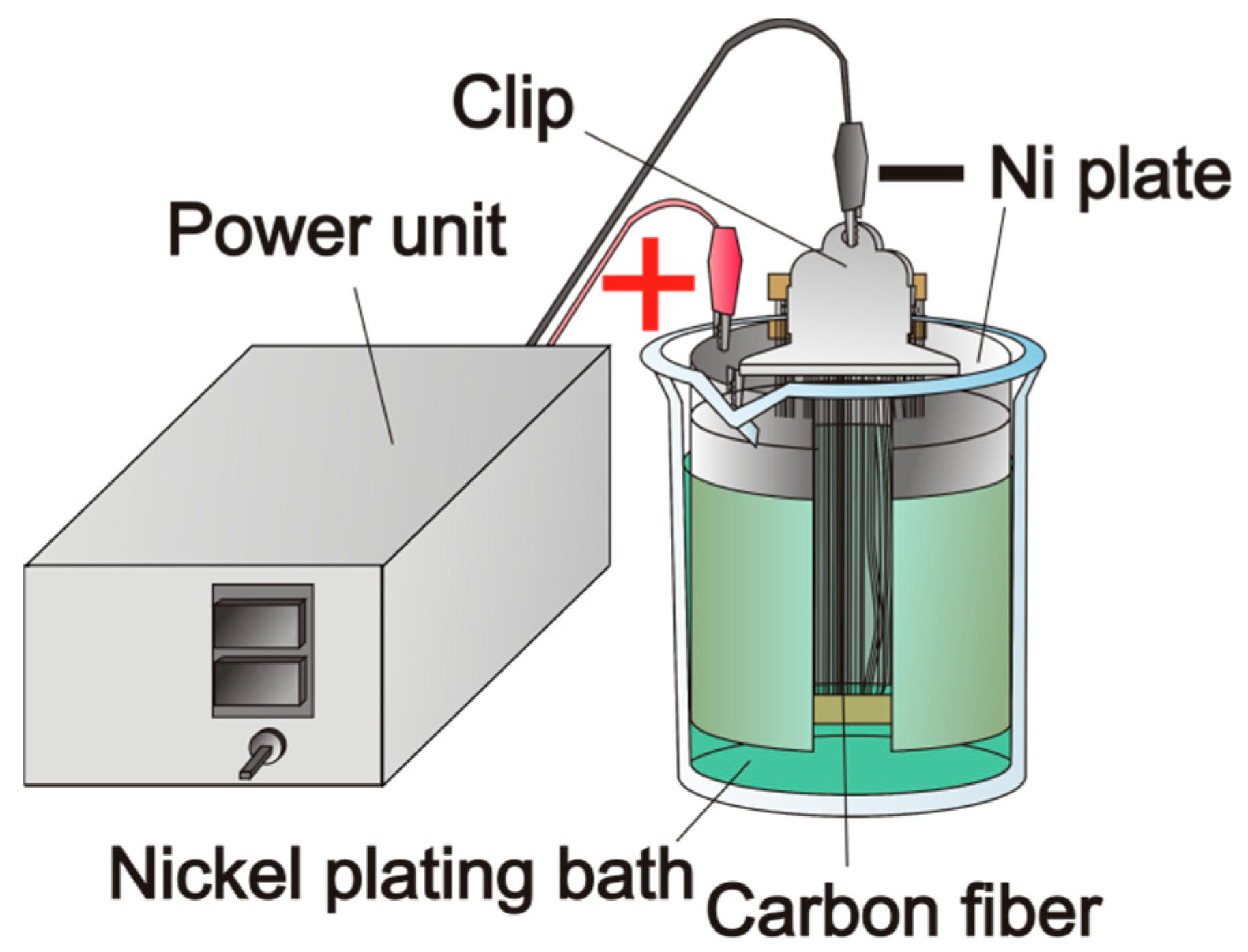
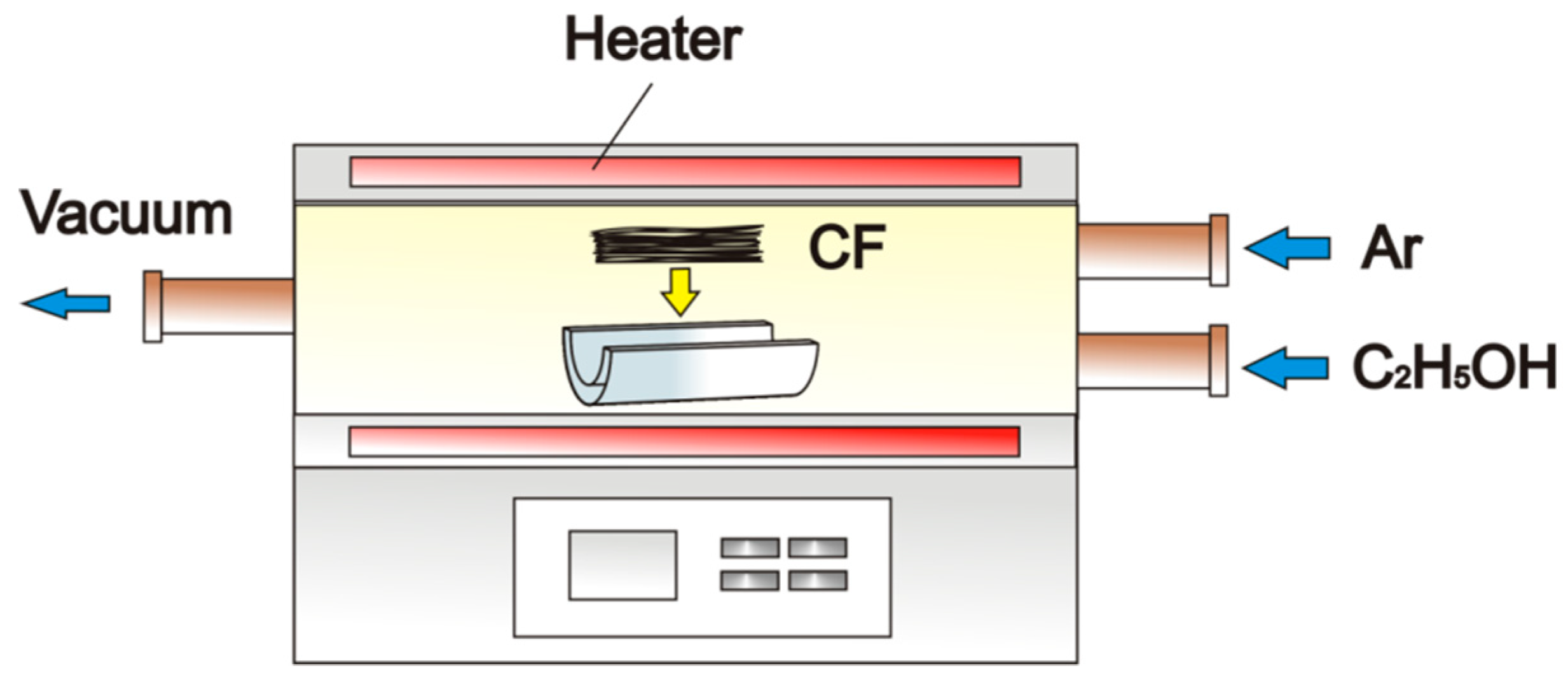
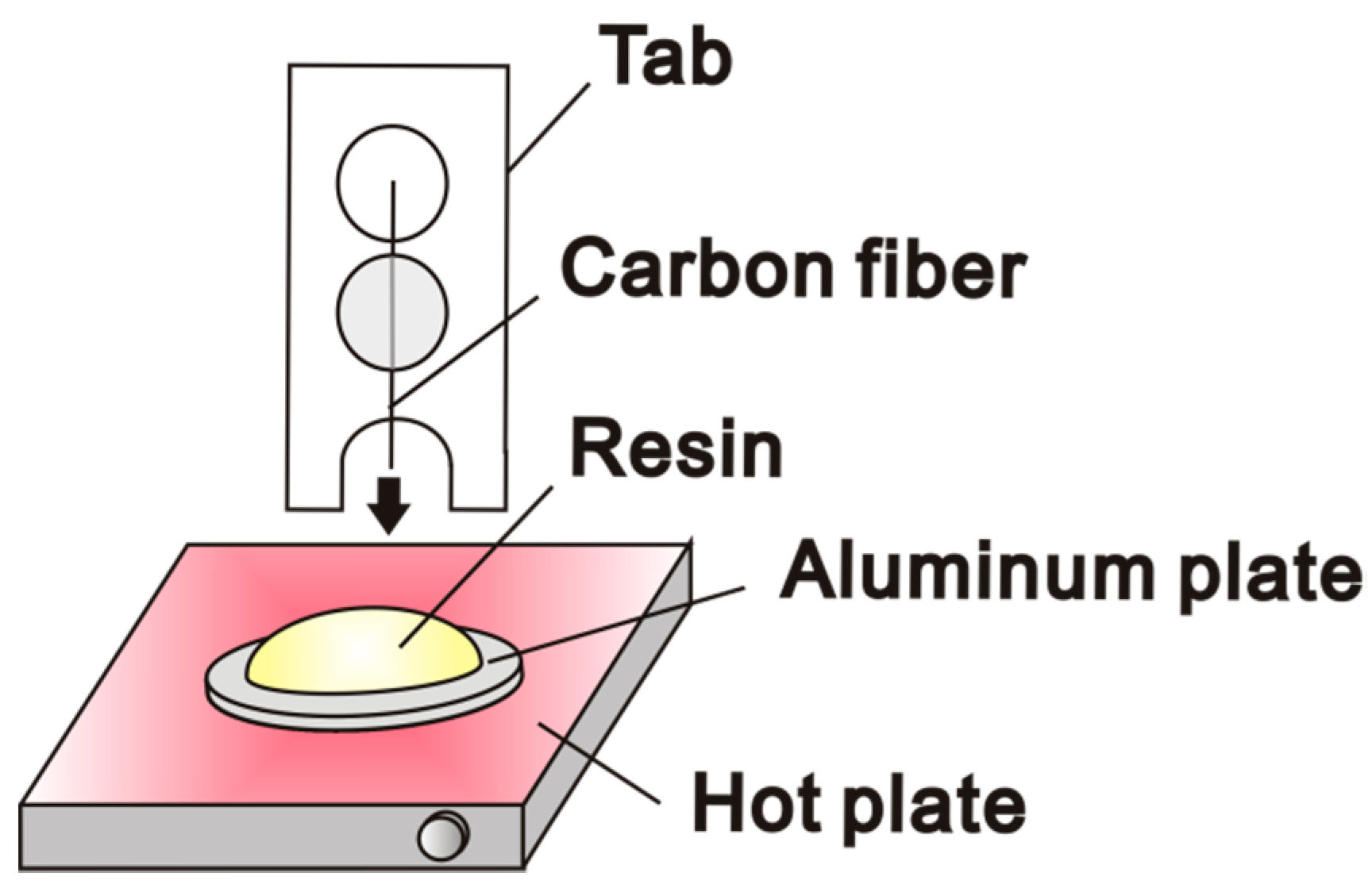
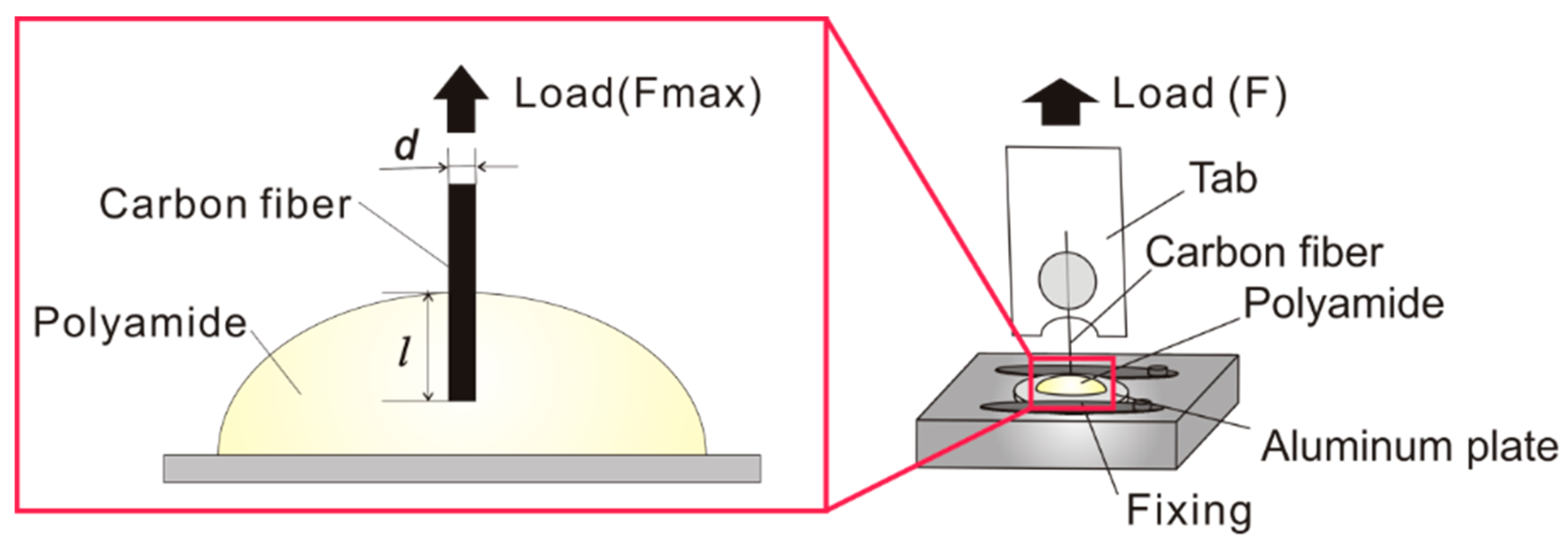

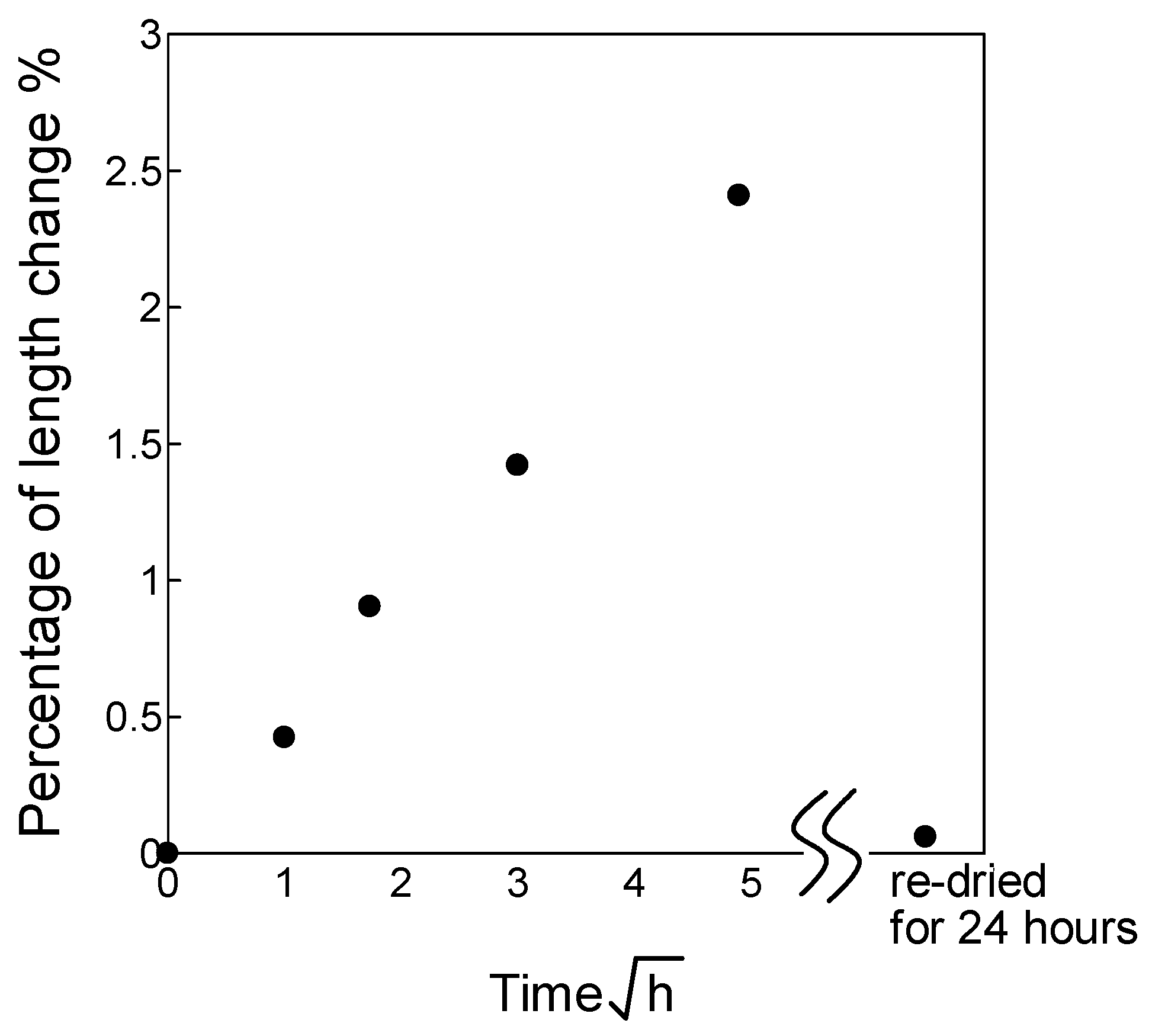
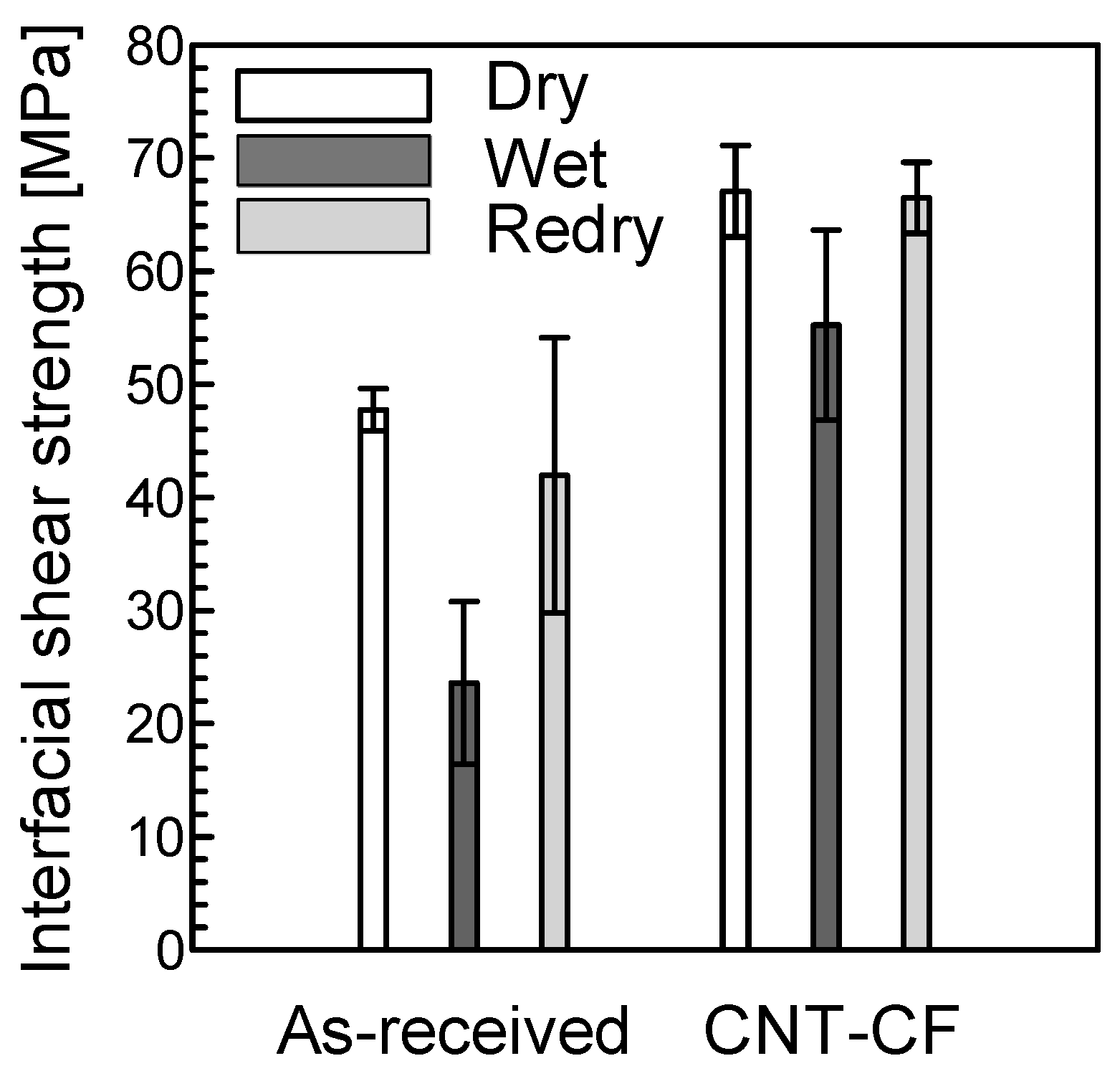




© 2019 by the authors. Licensee MDPI, Basel, Switzerland. This article is an open access article distributed under the terms and conditions of the Creative Commons Attribution (CC BY) license (http://creativecommons.org/licenses/by/4.0/).
Share and Cite
Tanaka, K.; Okuda, S.; Hinoue, Y.; Katayama, T. Effects of Water Absorption on the Fiber–Matrix Interfacial Shear Strength of Carbon Nanotube-Grafted Carbon Fiber Reinforced Polyamide Resin. J. Compos. Sci. 2019, 3, 4. https://doi.org/10.3390/jcs3010004
Tanaka K, Okuda S, Hinoue Y, Katayama T. Effects of Water Absorption on the Fiber–Matrix Interfacial Shear Strength of Carbon Nanotube-Grafted Carbon Fiber Reinforced Polyamide Resin. Journal of Composites Science. 2019; 3(1):4. https://doi.org/10.3390/jcs3010004
Chicago/Turabian StyleTanaka, Kazuto, Saya Okuda, Yoshitaka Hinoue, and Tsutao Katayama. 2019. "Effects of Water Absorption on the Fiber–Matrix Interfacial Shear Strength of Carbon Nanotube-Grafted Carbon Fiber Reinforced Polyamide Resin" Journal of Composites Science 3, no. 1: 4. https://doi.org/10.3390/jcs3010004
APA StyleTanaka, K., Okuda, S., Hinoue, Y., & Katayama, T. (2019). Effects of Water Absorption on the Fiber–Matrix Interfacial Shear Strength of Carbon Nanotube-Grafted Carbon Fiber Reinforced Polyamide Resin. Journal of Composites Science, 3(1), 4. https://doi.org/10.3390/jcs3010004



